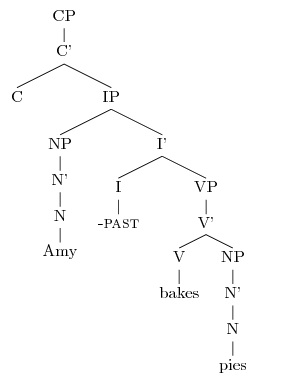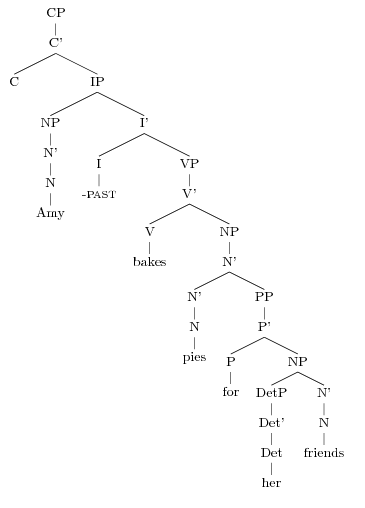Amy Reynolds
Linguistics PhD student, UNC-Chapel Hill
Drawing Sentence Syntax Trees
Now that you’ve learned about X-bar structure and determining constituency, you should be able to draw syntax trees. However, there are all sorts of different types of phrases and ways that they can connect, and you have a sentence you need to draw a tree for. What to do!? This page is designed to help guide you through drawing syntactic trees.
We will walk through how to make trees for the following sentences:
Amy bakes pies.
Amy bakes pies in the summer.
Amy bakes pies for her friends.
Amy thinks that she will bake pies.
Step 1: The IP and CP phrases
There are two Phrases that are the basis of every clause: the Complementizer Phrase (CP) and the Inflectional Phrase (IP). Since we know that every sentence/clause must have these two phrases, we will start off our tree by drawing a beginning CP and IP structure. These two are assumed to combine the same way every time: 
As noted above, we automatically expect the head of the Inflection Phrase (IP) to contain the overall tense of the clause, denoted here by the (+/-) PAST feature. Other words that can appear in the head position of the IP include modal (e.g. could, should, would, might, etc.) auxiliaries. However, regardless of whether there is an actual word within the sentence, you should always show the complete IP structure, especially including I.
Step 2: Adding the Subject and Predicate
Within the IP structure, there are specific places which consistently are reserved for different parts of the sentence. Specifically, the specifier of IP is the subject of the clause (and hence, is always an NP), and the complement of IP is the predicate (i.e. verb) of the clause. This is shown in the following Tree structure: 
Looking at our sentence Amy bakes pies, we see that Amy is the subject and bakes is the predicate. This gives us the following tree structure so far: 
Note that now that we are beginning to actually use the structure for a sentence, I contains the feature -PAST because the sentence is in the present tense. Since there is no auxiliary present, just the I with the Tense feature is shown. Be sure to include all three levels of each phrase in your work — they are important for showing if you think that something is a specifier, complement, modifier, or head. Also, be sure that your Heads match up with the phrase that you are assuming that they head (e.g. a phrase cannot be the head of another phrase).
Step 3: Add other specifiers, complements and modifiers to the phrases
Now that we have the subject and predicate inserted into the structure, it is important to next consider what happens to the rest of the words and phrases left in the sentence. For instance, for the sentence Amy bakes pies, we have Amy and bakes covered, but how does pies attach to the sentence?
Consider the status of the predicate within the sentence. In this instance, the predicate is a transitive verb, which means that it requires a direct object. You must bake something. Pies, then is a complement to the VP because it is required by the head of the VP. Specifically, we know that pies is an NP, because it can be replaced with other nouns as well. This leads us to the following structure:
 Now consider if the sentence was Amy bakes pies in the summer. We know that Amy, bakes, and pies should all appear in the same positions as they do in the tree above. But what about the phrase in the summer?
Now consider if the sentence was Amy bakes pies in the summer. We know that Amy, bakes, and pies should all appear in the same positions as they do in the tree above. But what about the phrase in the summer?
We would say that in the summer is a modifier of the VP. Why? Here, it is not adding additional information about the pies, instead, it is telling us when the baking is taking place. We specifically know that it must be a modifier rather than a complement, because the verb does not require that additional information about the baking — not like it requires the direct object pies. Since in the summer is a modifier of the VP, we add another higher up V’ node, so that it can be a sister to the lower V’. Hence, we get the following structure:
 Note that within the PP, NP is a complement because it is required by the head in.
Note that within the PP, NP is a complement because it is required by the head in.
Now if we changed the sentence to Amy bakes pies for her friends, should the PP for her friends be in the same location? There are two possibilities here: either Amy is baking for her friends, and what she is baking is pies; or there are pies for her friends that Amy is baking. In the first instance, it is the action (baking), that is being modified, and for her friends in that instance would be a modifier of the VP, as in the summer was in the structure above. In the second instance, the object that Amy is baking is pies for her friends. If that were the case, for her friends would not be a modifier of the VP and instead would be a modifier of the NP, as shown in the structure below:

The slight differences in meaning between the two possible structures of the same sentence can be captured if we think about corresponding questions that could be asked. If you asked What does Amy bake for her friends? (where the PP is modifying the VP), an appropriate answer could be Pies, not cupcakes, where you are answering simply with nouns, no additional phrases added (because nothing else is branching from that NP). On the other hand, if you asked What does Amy bake? for this sentence, an appropriate answer could be Pies for her friends, not cupcakes for her family, which shows that the prepositional phrases are acting as modifiers distinguishing who the objects in question are for, not who she is baking for. In that instance, the PP would be a modifier of the NP, not the VP.
Step 4: Add CPs if there are any
Within your sentence, there may be multiple clauses. If that is the case, then you can expect a Complementizer Phrase to show up. The basic structure for a CP that occurs lower in the sentences’ tree is exactly like that CP that contains the entire sentence, described above. There are two types of CPs that can occur within a larger CP phrase: CPs for complement clauses, and CPs for relative clauses. Depending on the CP type, it will attach to the larger sentence in different ways. Because CPs for relative clauses show movement, they will be covered in the Drawing Question Syntax Trees. For now, we are going to cover the CPs that are complement clauses. How these in particular attach to the larger tree should be easy to remember: the CP for a complement clause should always occur as a complement to the phrase it is attaching to. Let’s consider the sentence Amy thinks that she will bake her pies. We already know the basic structure for Amy thinks. What about that she will bake her pies? This is what we call a complement clause, which contains a ‘mini-sentence’ of sorts — this same clause could stand alone as the sentence She will bake her pies.
In this instance, the complement clause is required by the verb thinks, which reinforces the fact that the CP is a complement to the VP in this instance, giving us the structure below: 
Notice that the structure of that she will bake her pies is exactly like that of what we would make for the sentence she will bake her pies, except that the word that introduces the complement clause (that) occupies the head position of the CP. Overall, the entire CP attaches as a complement to the VP contained within the higher CP. In fact, it may be handy to remember that in English, at least, a complement clause will always attach to a VP as a complement — complement clauses do not attach to NPs.
Now that you understand how to draw syntax trees for sentences, you are ready to learn how to draw trees for questions, as well.

University Operator: (919) 962-2211 | © 2024 The University of North Carolina at Chapel Hill |